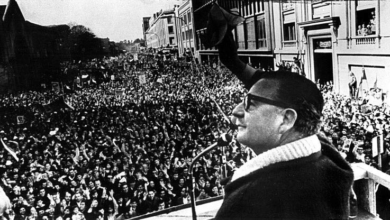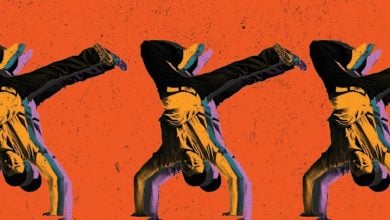Photo: Senator Joseph McCarthy giving a presentation at a 1954 hearing
The Red Scare of the 1950s is making a comeback. The name and legacy of Senator Joseph McCarthy, who led the anti-communist purges and blacklistings of this period, is invoked across the political spectrum as a synonym for unjust persecution. But when it comes to smearing those who oppose the new Cold War against Russia and China, his approach to politics is alive and well. And one of the key present-day practitioners of Red Scare paranoia is the New York Times.
Its headlines reliably follow the priorities of Pentagon and State Department hawks. As economic decoupling gathers pace, the Times ran an article last month titled “As Ties to China Turn Toxic, Even Chinese Companies Are Breaking Them.” It promotes the myth that the Chinese government is coming after Americans with headlines like “Was an Ex-N.Y.P.D Sergeant a Chinese Agent or an Unwitting Pawn?” or “China Investing in Open-Source Intelligence Collection on the U.S.” (“open-source intelligence” means publicly available information, so collecting it involves nefarious activities like a Google search). And the Times downplays any positive news about the country with ridiculous opinion pieces like one in 2021 titled “Has China Done Too Well Against Covid-19?”
In the McCarthyist witch hunt of the 1950s, thousands of U.S. union organizers, writers, actors, musicians, scientists, government workers, teachers, and academics had their names and reputations dragged through the mud and were officially blacklisted from their industries. They also faced civil and criminal charges, exile, and even execution on the basis of their alleged political beliefs. Targets of the Red Scare included world renowned figures like W.E.B. DuBois, Langston Hughes, Albert Einstein, Pete Seeger, and playwright Arthur Miller – the originator of the modern usage of the term “witch hunt” whose 1953 The Crucible dramatizes the Salem witch trials and was written as an allegory for McCarthyist persecution.
The Times has never retracted or apologized for its role in McCarthyism, and has often been more eager to defend the legacy of the Red Scare than it has critically reckoned with its past. In the 1990s after the collapse of the Soviet Union and the opening to the west of Soviet archives, the Times published numerous articles and op-eds vindicating the period despite its excesses – “Rethinking McCarthyism, if Not McCarthy” for a new generation. Even the ‘critical’ analyses of that period presupposed anti-communism as good and simply critique the methods and ‘demagoguery’ of McCarthy as an individual.
The word McCarthyism itself obscures the fact that this paranoia dominated U.S. media and society even before McCarthy became a main player. The Times often used red-baiting as a tactic against progressive movements at the time. In 1948, leaders of the Communist Party including Benjamin Davis, Henry Winston, and William Z. Foster were arrested under the Smith Act for nothing other than their political beliefs. The Times used the arrests to smear third party progressive presidential candidate Henry Wallace as a communist puppet.
Wallace, who was Franklin Roosevelt’s vice president between 1941 and 1945 and a sincere progressive, critiqued the arrest of the Communist Party leadership as “an unconstitutional attempt by the Truman Administration and ‘bi-partisans’ to create fear in order to stay in power.” The Times branded Wallace as a conspiracy theorist for this assertion. And the hostility of the paper to third party challengers has remained consistent, especially in the wake of the 2016 election where Green Party candidate Jill Stein was repeatedly smeared as a ‘Russian asset’ on ridiculous grounds by the Times.
Racism and anti-communism go hand-in-hand
The same strategies applied to discredit third party electoral challenges were used to undermine the legitimacy of and public support for growing mass movements. As the Civil Rights Movement was cresting in 1964 and about a year after the March on Washington, the Times was still running stories like “A Mississippian Sees Reds in [Civil] Rights Drive,” quoting at length segregationist Mississippi representative John Bell Williams: “We know that W.E.B. DuBois, a founder of the NAACP, was an old Communist.” The article also uncritically repeats similar accusations against A. Phillip Randolph, Bayard Rustin, and Martin Luther King Jr., who the article alleges was “trained at a Communist institution in Tennessee.”
Finally, the article engages in another trope that became prominent again in the aftermath of the 2020 uprisings for Black liberation: the “outside agitator.” The Times article promoted the claim that a white man arrested in Jackson, Mississippi, “admitted to police and FBI agents that he was a Communist,” while also being “on the payroll of CORE,” the Congress of Racial Equality.
Leaders of the Black liberation struggle were most viciously attacked—whether outspoken communists like New York City councilman from Harlem Ben Davis or luminary academics and artists like W.E.B. DuBois, Langston Hughes, and Paul Robeson. Robeson, rightly remembered today as a hero with towering accomplishments in a wide range of fields, was described by the Times in 1949 as a “Black Stalin” with “delusions of grandeur.”
Teachers the target of right-wing hysteria
Throughout the 1940s and 50s, the Times engaged in rootless speculation and often openly admitted to doing so. There was an intense focus on targeting teachers. A series of 1952 articles, despite stating in the first paragraph that “there is no factual frame of reference by which to judge the accuracy” of the accusations that there are hundreds of card-carrying communists in New York City schools, continues to fear monger relentlessly about communists promoting their “conspiratorial philosophy in the classroom.” Letters to the editor from paranoid parents were regularly featured throughout these years.
It is no coincidence that this paranoid obsession with schoolteachers subverting children with ‘conspiratorial philosophies’ is once again resurgent on the right. This takes the form of attacks on teachers’ unions, so-called ‘critical race theory’ being taught in schools, “don’t say gay” bans and attacks on trans students — all trends that the Times once again pretends to be critical of while routinely publishing and promoting some of the most vile attacks on union organizing, queer and trans youth, and movements against racism.
Alongside the Red Scares, the so-called ‘Lavender Scare’ was a parallel campaign to root out lesbians and gays from U.S. government institutions from the State Department to NASA, built similarly on unfounded accusations and an atmosphere of paranoia. Union organizers, affiliated with communist organizations or not, were the first to be accused of such and driven from public life.
“Journalism” in the interests of the rich and powerful
In the famous case of Julius and Ethel Rosenberg, executed for allegedly sharing nuclear secrets with the Soviet Union, the Times took up an entire column on the front page to relish in their deaths, providing a play-by-play of the execution. In the months preceding the execution, no opportunity was missed to demonize the pair. In particular, coverage of international solidarity from the socialist camp was cited as a smoking gun to prove communist states used the case to “incite hatred of the United States and western democracy.” The Times was self-consciously in a battle of ideas against the emerging bloc of socialist and anti-colonial governments, and sought to inoculate U.S. workers against this camp’s message that focused on world peace and racial equality.
The concern with inoculating U.S. workers against communist agitation is a key characteristic of the Red Scare. A 1948 letter to the editor makes this case in a way that almost reads as cheeky and sarcastic to modern eyes—pushing back on the Times’ editorial position against salary raises for public school teachers, the author contends that “Underpaid school teachers” are “prey to communist propaganda.” In closing the writer asks, “Does The New York Times, then, which supports 15 billions of dollars for the physical defense of America against Russia believe the comparatively few dollars it would take to pay teachers a decent wage is too high a price to pay to secure the front lines of our defense of the minds of American youth?”
Elite politicians and the ultra-wealthy have few tools to shape the consciousness of the public as effective as the New York Times. Over the course of its 170-plus years of existence, the Times has never strayed from this basic mission. Whether it was the journalists of the 1950s trying to convince us that there were communist agents lurking around every corner or today’s writers stoking anti-China hysteria, the New York Times always stands ready to trample on the truth if it serves the interests of the rich and powerful.






